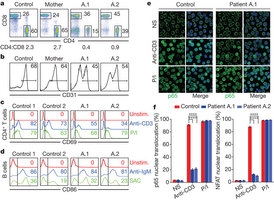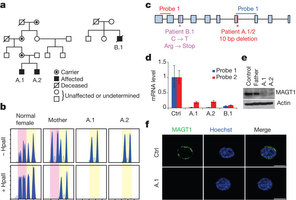摘要:镁离子是哺乳动物细胞中最丰富的二价阳离子,是动物和植物中ATP、核酸和无数种酶的一种必要的辅因子。它是否(像钙一样)在细胞内信号作用中起第二个信使的作用一直存在争议。新的证据表明,它是这样的。Li等人在一种新的与X-相关的免疫缺陷中识别出了胞质膜镁运输因子MAGT1中的突变,并且发现镁在T-细胞受体和EGF受体触发的反应中起第二个信使的作用。这一发现说明MAGT1为新的治疗方法提供一个可能的目标。
生物探索推荐英文论文摘要:
Nature 475, 471–476 (28 July 2011)
Doi:10.1038/nature10246
Second messenger role for Mg2+ revealed by human T-cell immunodeficiency
The magnesium ion, Mg2+, is essential for all life as a cofactor for ATP, polyphosphates such as DNA and RNA, and metabolic enzymes, but whether it plays a part in intracellular signalling (as Ca2+ does) is unknown. Here we identify mutations in the magnesium transporter gene, MAGT1, in a novel X-linked human immunodeficiency characterized by CD4 lymphopenia, severe chronic viral infections, and defective T-lymphocyte activation. We demonstrate that a rapid transient Mg2+ influx is induced by antigen receptor stimulation in normal T cells and by growth factor stimulation in non-lymphoid cells. MAGT1 deficiency abrogates the Mg2+ influx, leading to impaired responses to antigen receptor engagement, including defective activation of phospholipase Cγ1 and a markedly impaired Ca2+ influx in T cells but not B cells. These observations reveal a role for Mg2+ as an intracellular second messenger coupling cell-surface receptor activation to intracellular effectors and identify MAGT1 as a possible target for novel therapeutics.

Figure 1: Patients have a proximal TCR activation defect.

Figure 2: Patients have MAGT1-null mutations.







